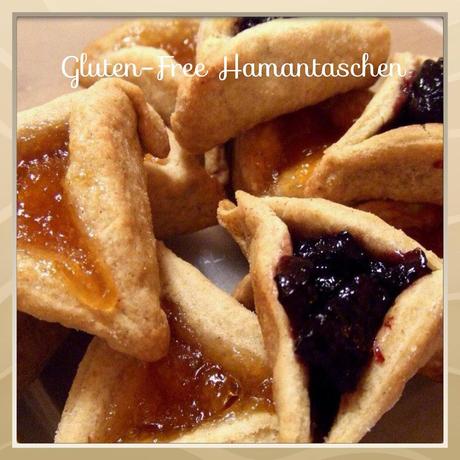
Purim is coming! Purim has always been my favorite Jewish holiday, probably because it’s one of the few where you can make noise in synagogue and it’s not only ok, it’s encouraged. Everyone gets noisemakers called groggers and you can stamp your feet loudly.
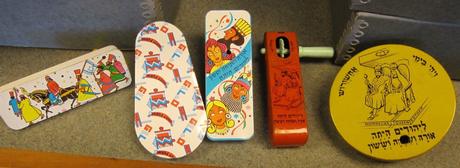
It’s the most fun you get to have in temple. Over the years, even into my adulthood, Purim has taught me many lessons.
Lesson One: when I was a child, I loved when Purim came along because at school, we got to dress up in costumes to act out the Book of Esther, also known as the Megillah.
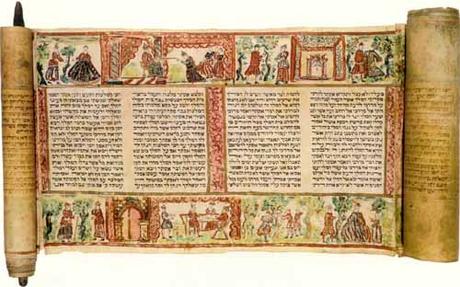
It was often likened to Jewish Halloween. In the mind of a child, however, information gets processed differently. Not only were we encouraged to come to school in costume so we could act out Esther’s story but we were taught about mat’not evyonim which is giving food to the hungry. It is tradition to make care packages of food and goodies and go to the doors of people who might not be able to get their own and offer them. It is also tradition to give gifts of food to friends which is called shalach manot.

Somehow that led to me coming home from school in my costume and going door-to-door in my apartment building, not offering treats but asking for them! I lived in the South Bronx and we were the only Jewish family in the neighborhood so no one understood what I was doing ringing doorbells in costume asking for treats…in March! Neighbors asked why I was trick-or-treating in March and didn’t I know it wasn’t Halloween. I’m sure I tried to explain my 6-year old understanding of Purim to them while they went to call my parents. Lesson learned – Purim is NOT Jewish Halloween.

Lesson Two: the Book of Esther is all about how she saved her fellow Jews from persecution at the hands of Persian King Achashverus and his adviser, Haman. When it was time to act out the story in school, all the girls wanted to be Esther. For some reason, the teachers always chose a blonde girl to play Esther. Even the books and noisemakers we had showed Esther as blonde and Queen Vashti, who we were taught was “bad,” as brunette. As much as I wanted to be heroine, my dark hair always got me cast as Vashti.

“La Toilette d’Esther” by Theodore Chasseriau
When I was older, I understood the story much differently. Queen Vashti was considered “bad” because when her drunken husband called for her to come “entertain” his buddies during a feast, she refused. As a result of her standing up for herself, she was beheaded.

“Vashti” by Edwin Long
Esther did save the Jews but she did it by using her beauty and making the king fall in love with her. Lessons learned – good and bad is not decided by hair color and strong women who make noise do not get good press in the Bible.
Lesson Three: there is a possibility that Esther was vegan. Tradition says that when she moved into the palace, she only ate fruit, seeds, nuts, grains and legumes. This was most likely so Esther could follow Jewish dietary laws without being given away as a Jew.

Watch the movie https://www.youtube.com/watch?v=EQR9eB_Dw1g
Many people add seeds, nuts and legumes to their Purim menus as a tribute; making the entire Purim menu vegan is an even better tribute. Lesson learned: being meat-free helps save lives (but we already knew that, right?).
Lesson Four: On Shalom Veg, a web-based group for Jewish vegetarians, vegans and animal rights advocates, there is an article called “Purim – What are We Blotting Out?” The article states, “We are commanded on Purim to try to wipe away evil in our world. But we are also told that we must first hear, recognize and remember the evil. It is up to us to make the conscious choice to pay attention and do what we know is right, to be kind to each other, and do our best to bring healing instead of pain to the world.”
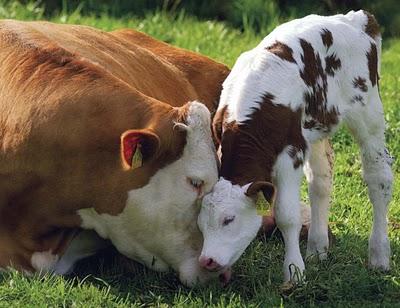
Dr. Richard Schwartz of Jewish Vegetarians of North America draws a lot of connections between Purim and being meat-free in his article “Purim and Vegetarianism.” Lesson learned – it makes no sense to celebrate a people’s deliverance from death by feasting on death. How hypocritical is it to celebrate the saving of lives by participating in the taking of lives by eating animals. How does it celebrate Spring, Purim, Easter or anything to murder an innocent lamb?
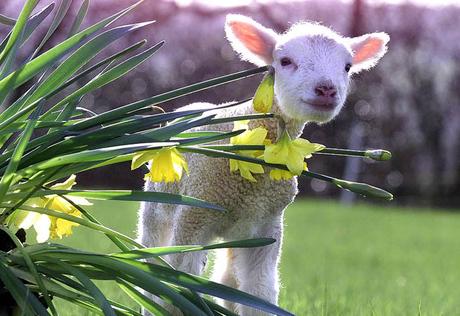
Purim is the perfect time to take all these lessons and celebrate the holiday, and life, with a vegan menu and a vegan life.
One of the traditional foods we eat at Purim is Hamantaschen. Hamantaschen are triangular-shaped pastries usually filled with fruit preserves and/or poppy seeds.
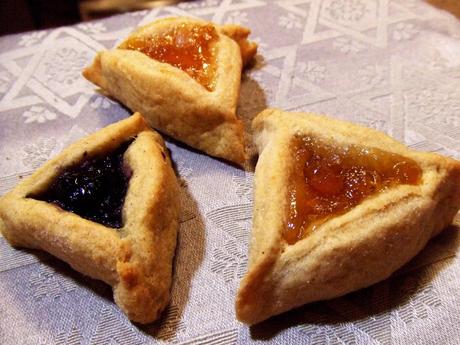
“Hamantaschen” is a Yiddish word meaning “Haman’s pockets” though it is thought that the triangular shape represents the three-cornered hat that Haman wore.
My first attempt at making Hamantaschen, both sweet and savory, was ok but not great. Then I perfected my gluten-free, vegan Hamantaschen.
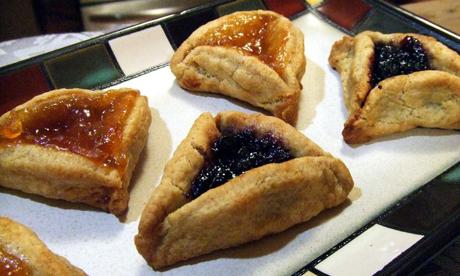
I used specific flours in this recipe but you can use a gluten-free, all-purpose flour mix instead. These have blueberry and apricot preserves but you can use any filling you want such as prune, fig, raspberry, etc. Fig is one of my favorites – they taste like Purim fig newtons.
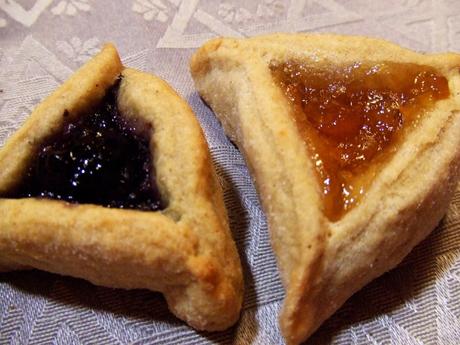
If you want to make chocolate Hamantaschen, simply add some cocoa powder to the flour mix. These Hamantaschen are tender, chewy and delicious. That’s definitely something to shake my grogger about! Enjoy!
Vegan, Gluten-Free Blueberry and Apricot Hamantaschen
GF

1¼ cup white rice flour
½ cup tapioca starch
2 tsp. xanthan gum
4 tsp. baking powder
½ tsp. kosher salt
¾ cup sugar
¾ cup cold vegan butter, cubed
1 tsp. vanilla extract
1 tsp. almond extract
½ cup cold water
Fillings: apricot and blueberry preserves
Cooking spray
Preheat the oven to 375 degrees. Add the dry ingredients into a food processor and mix well. Add in the cubed butter and pulse until the dough looks like sand. Add the vanilla and almond extracts to the dough and then add water slowly, pulsing, until the dough comes together. Transfer the dough onto a work surface and form a ball. Separate it into 2 discs and wrap each half of the dough in plastic wrap and refrigerate it for one hour.
After the hour, take out one disc and using a tablespoon, take pieces of dough and form them into balls. Put each ball between two small pieces of parchment paper. Press down on the ball with your hand to form a flat disc, about ¼” thick, or you can use a rolling pin. Place about 1 tsp. of filling onto the center of each disc.
Fold the edges of the disc up into a triangle (handling it by the parchment paper makes it easier) and pinch the corners. Continue until you use up all the dough. Place Hamantaschen onto a parchment covered baking sheet. Spray Hamantaschen with cooking spray. Bake for 10 minutes, then rotate the pan and bake an additional 5 minutes or until Hamantaschen are slightly browned. Remove from oven and let cool. Store in a covered container to keep them fresh.
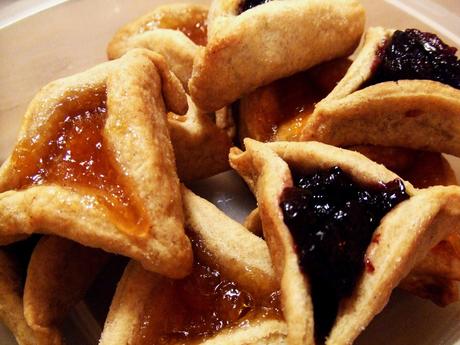
The “V” Word: Say it. Eat it. Live it.
Print Vegan, Gluten-Free Hamantaschen Author: Rhea Parsons Recipe type: Dessert Cuisine: Jewish Serves: 15-20 cookies Ingredients- 1¼ cups sorghum flour
- 1¼ cup white rice flour
- ½ cup tapioca starch
- 2 tsp. xanthan gum
- 4 tsp. baking powder
- ½ tsp. sea salt
- ¾ cup sugar
- ¾ cup cold vegan butter, cubed
- 1 tsp. vanilla extract
- 1 tsp. almond extract
- ½ cup cold water
- Fillings: apricot and blueberry preserves
- Cooking spray
- Preheat the oven to 375 degrees. Add the dry ingredients into a food processor and mix well. Add in the cubed butter and pulse until the dough looks like sand. Add the vanilla and almond extracts to the dough and then add water slowly, pulsing, until the dough comes together. Transfer the dough onto a work surface and form a ball. Separate it into 2 discs and wrap each half of the dough in plastic wrap and refrigerate it for one hour.
- After the hour, take out one disc and using a tablespoon, take pieces of dough and form them into balls. Put each ball between two small pieces of parchment paper. Press down on the ball with your hand to form a flat disc, about ¼” thick, or you can use a rolling pin. Place about 1 tsp. of filling onto the center of each disc.
- Fold the edges of the disc up into a triangle (handling it by the parchment paper makes it easier) and pinch the corners. Continue until you use up all the dough. Place Hamantaschen onto a parchment covered baking sheet. Spray Hamantaschen with cooking spray. Bake for 10 minutes, then rotate the pan and bake an additional 5 minutes or until Hamantaschen are slightly browned. Remove from oven and let cool. Store in a covered container to keep them fresh.
